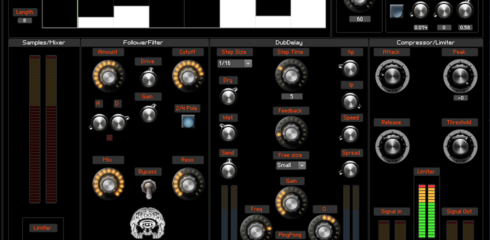Best of Reaktor User Library july 2.016
Samplers
Sample
by Dino Sabatini
Sample is a sampler/sequencer, very intuitive and easy to use and has been the ensemble that I have used most in my productions. It consists of a trig sequencer and a pitch sequencer, the sampler is followed by a wrapper module, modulated by an envelope follower and an LFO and to avoid possible damage to the speakers I added a Mixer/Limiter (if you are working with the wrapper I recommend using it if the compressor/limiter is turned off). The signal then passes through the filter (Follower filter 2/4 pole “Moog style") then passing through a dub delay and finally through a mastering compressor / limiter.
I would like to point out that to do this I have also used some parts taken from the Reaktor user library which I then modified to integrate them into the ensemble. This is what I believe is a major strength of Reaktor and for that I would like to thank all users that like me and just for pure passion are working since years on the development of this amazing and infinite software.
***
Sequencers
Angharad
by david elson
8 track MIDI gate sequencer
***
Synthesizers
Auralis Modded 3.4b
by Jim Hurley
{This is for Reaktor 5 and 6}
Auralis was released about 13 years ago by Kristian Thom; it has been my favorite ensemble - indeed it was the main reason I fell in love with Reaktor.
I did a few changes and updates for it, mostly a lot of little things, and I tried not to change it's impish, quirky nature.
The major sonic change was that I replaced the delay lines in the waveform oscillator with diffuser delays. With diffusion at 0, they are just simple delays, as in the original.
I changed some of the effects: the EQ was unchanged, the limiter was updated with a compressor from the NI library, the reverb was replaced with micro space from the NI library, and I added a delay and phaser from the U/L. The effects are processed in the top-down order you see on the panel. The effects consume no CPU when shut off.
There were many small changes - randomizers from rachMiel, a snapshot change muter from Dietrich Pank, a snapshot breeder from Colin Brown, and the EZ FFT display from the U/L.
I also added a waveform display, added comments here and there, simplified some of the internals, and tweaked a few things. Everything should be commented internally.
There are over 500 new snapshots made just for this ensemble. The snapshot names are not meaningful, it's hard to come up with 500 names, so a lot of them are monsters and fantastic creatures. The snapshots are not in any particular order - mostly the order I made them - so some good ones are near the end as I got better. Most of them were made using Colin's snapshot breeder, finding good candidates and tweaking the parameters. All of the snapshots were made for the Random note player - I didn't setup any for the keyboard, so you will need to tweak that envelope if you 'play' Auralis.
In version 3.4, there are 2048 snapshots, most made from the breeder.
If the solo instrument is still too CPU hungry for you, disconnect the EZ FFT display.
There remain some bugs: the geiger module used in the random note player sometimes takes a while to start up; the snapshot breeder modifications I made sometimes generate an event loop error.
Included you will find another ensemble which uses the 'rachToys' ensemble for further intrigue. But be forewarned it is a CPU guzzler. Also, a superformula stereo dispersion version is also included for those with CPU to burn. Maybe you will need to lower the number of stages.
***
Auralis wavetable
by Paule Amca
a mod of a modded instrument
Changed the original osc and lfo with Bruno 3400 wavetables & xfx drive by X/Y waves.
Start the clock for using modulations.
Original by Kristian Thom 2003.
Modded by Jim Hurley 2016
***.
Black Magic X
by Michael Stocker
Black Magic X is a (semi-)modular Synth designed with the fantastic Modular-X framework by Herwig Krass.
This release focuses on a (probably stupid) idea: The oscillators (actually it is one + a bunch of waveshapers) are designed to have a cycle length that is an integer divider of the sample rate. The huge advantage: All aliasing that you get from the oscillator and/or the further processing will be harmonic. The drawback: You loose quite a bit of pitch resolution. Hence the name: We sacrifice something that we should value to get something else we want... typically it is a bad deal...
Disclaimer: Reaktor oscillators have pretty good anti-aliasing. The slightly weired approach of this ensemble is mainly useful, when you want to do a lot of waveshaping/FM/non-linear processing. For straight saw/square waves the usual approaches might be better.
Disclaimer II: The ensemble is rather rough around the edges. The modules are crowded, a lot of stuff is not labeled well and there are some leftovers in the structure, that go nowhere...
Random observation: Overall this approach can sound a bit like synths based on divide down circuits (which is essentially, what it does).
Reverb is stolen from West// by Icaro Ferre:
http://www.native-instruments.com/de/reaktor-community/reaktor-user-library/entry/show/8123/
!!!!!!!!!!!!!!!!!!!!!!!!!!!!!!!!!!!!!!!!!!!!!!!!!!!!!!!!!!!!!!!!!!!!!!!!!!!!!!!!!!!!!!!!!!!!!!!!!!!!!!!!!
IMPORTANT: Your Reaktor sample rate should be identical to your real sample rate for this "deal" to work
!!!!!!!!!!!!!!!!!!!!!!!!!!!!!!!!!!!!!!!!!!!!!!!!!!!!!!!!!!!!!!!!!!!!!!!!!!!!!!!!!!!!!!!!!!!!!!!!!!!!!!!!!
***
Contrast Sequenced Synthesizer
by Defunkt Dialekt
Sequenced Synthesizer created to make the new EP by Demon Ray on Irrational Media
uses a couple of old macros from the user library, full credits to be given as soon as I can trace back where they came from....created in jan 2015
more info to come
Uses Limelite Magic macro (one of my favs)
Includes the SSL Compressor for the output by Benjamin Suthers (awesome!)
most knobs have hover info
http://irrationalmedia.co.uk/
***
JP-4c Super Saw Emulation 1.7
by Alex Shore
In 1996 Roland released the JP-8000, their first virtual analogue modeling synthesiser. The JP-8000 became very famous for one thing, the Super Saw. This unique sound helped define the trance music genre and is still commonly used in electronic dance music production today.
The JP-4c is a Reaktor patch designed to emulate the infamous Super Saw oscillator.
The JP-4c is built upon a combination of research conducted by myself and other individuals, with the patch being able to effectively emulate the original Super Saw's unique timbre. Detailed research and analysis of the Super Saw found that the oscillator exhibits some interesting characteristics giving it a particular sound.
Detune Curve
Perhaps the most important element is the detune curve. Whereas many synthesisers would commonly use a linear detune amount, the Super Saw was found to have a varying detune amount through the use of a curve. This curve allows the user a much finer control over the detune amount applied to the oscillator, allowing them to create very smooth sounds with a minimal amount of detune or seemingly harsh textures as the amount is increased. This parameter has been accurately implemented within the JP-4c to achieve the same detune characteristics as the original.
Oscillator Shape
The original Super Saw oscillator makes use of a high pass filter to cut the harmonics below the fundamental frequency. This filter helps give the Super Saw its characteristic bright sound by attenuating the low frequencies while also shaping the waveform, producing a smoothing effect seen at the peaks. This effect has been carefully recreated within the JP-4c to achieve the same rich tone as the original.
Along with these, additional features have also been reproduced and implemented including a built array of sound shaping controls and effects detailed below.
SPECIFICATIONS
Super Saw Oscillator - Effective emulation of Roland's original layering of seven sawtooth waveforms
Second Oscillator - Four switchable waveform types (Triangle/Sine/Saw/Pulse)
Filter - Selectable Low Pass, Band Pass and High Pass with key follow
Modulation - 2x LFO, Filter Envelope and Pitch Envelope
Effects - Tone Control, Distortion, Reverb, Chorus, Delay, Stereo Spread and Portamento.
32 Factory Presets - 12 Leads, 8 Pads, 5 Plucks, 4 Basses and 2 Effects
REQUIREMENTS
This patch requires Native Instrument's Reaktor version 5.9.4 or later. Please refer to Reaktor's manual for further information.
***
